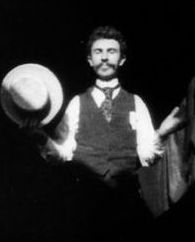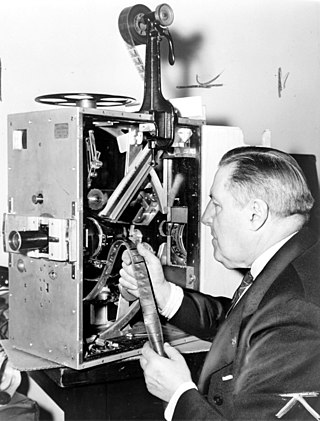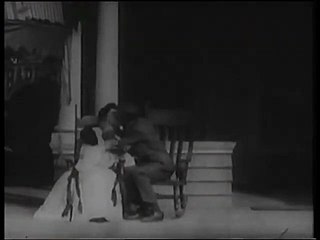
William Kennedy Laurie Dickson was a British inventor who devised an early motion picture camera under the employment of Thomas Edison.

Gottfried Wilhelm Bitzer was an American cinematographer, notable for his close association and pioneering work with D. W. Griffith.
The following is an overview of the events of 1895 in film, including a list of films released and notable births.

The Biograph Company, also known as the American Mutoscope and Biograph Company, was a motion picture company founded in 1895 and active until 1916. It was the first company in the United States devoted entirely to film production and exhibition, and for two decades was one of the most prolific, releasing over 3000 short films and 12 feature films. During the height of silent film as a medium, Biograph was America's most prominent film studio and one of the most respected and influential studios worldwide, only rivaled by Germany's UFA, Sweden's Svensk Filmindustri and France's Pathé. The company was home to pioneering director D. W. Griffith and such actors as Mary Pickford, Lillian Gish, and Lionel Barrymore.

Actuality film is a non-fiction film genre that, like documentary film, uses footage of real events, places, and things. Unlike documentaries, actuality films are not structured into a larger narrative or coherent whole. In practice, actuality films preceded the emergence of the documentary. During the era of early cinema, actualities—usually lasting no more than a minute or two and usually assembled together into a program by an exhibitor—were just as popular and prominent as their fictional counterparts. The line between "fact" and "fiction" was not as sharply drawn in early cinema as it would be after documentaries came to serve as the predominant non-fiction filmmaking form. Actuality is a film genre that remains strongly related to still photography.

Sherlock Holmes Baffled is a very short American silent film created in 1900 with cinematography by Arthur Marvin. It is the earliest known film to feature Arthur Conan Doyle's detective character Sherlock Holmes, albeit in a form unlike that of later screen incarnations. The inclusion of the character also makes it the first recorded detective film. In the film, a thief who can appear and disappear at will steals a sack of items from Sherlock Holmes. At each point, Holmes's attempts to thwart the intruder end in failure.

The Taming of the Shrew is a 1908 silent film directed by D. W. Griffith and produced by the American Mutoscope and Biograph Company of New York City. The 17-minute short, which is based on the play of the same name by English playwright William Shakespeare, was filmed in just two days–October 1 and 7, 1908–at Biograph's studio in Manhattan and on location in nearby Coytesville, a borough of Fort Lee, New Jersey.
Band and Battalion of the U.S. Indian School is a silent film documentary made on April 30, 1901 by American Mutoscope and Biograph Company made in Carlisle, Pennsylvania, USA. The cinematographer was Arthur Marvin. It depicts a parade drill by the cadet corps of the American Indian School which includes many representatives of the Native American tribes in the United States. The head of the parade was the renowned Carlisle Band of the Carlisle Indian Industrial School. In 1902 Marvin produced another documentary, Club Swinging at Carlisle Indian School for AM&B.

A Drunkard's Reformation is a 1909 American drama film directed by D. W. Griffith. Prints of the film survive in the film archive of the Library of Congress. The American Mutoscope and Biograph Company advertised the feature as "The most powerful temperance lecture ever depicted".

The Call of the Wild is a 1908 American short silent Western film directed by D. W. Griffith and produced by the American Mutoscope and Biograph Company. The short, a "one-reeler", stars Charles Inslee, Harry Solter and Florence Lawrence. Its interior scenes were shot at Biograph's studio facilities in New York City, and its exteriors were filmed on location in Coytesville, today one of the oldest communities in Fort Lee, New Jersey.
The Fight for Freedom is a 1908 American black-and-white short silent Western film which may have been directed by D. W. Griffith. Filmed in Shadyside, New Jersey in June 1908, the film was released on July 17, 1908.
Wallace McCutcheon Sr. was a pioneer cinematographer and director in the early American motion picture industry, working with the American Mutoscope & Biograph, Edison and American Star Film companies. McCutcheon's wealth of credits are often mixed up with the small handful of films directed by his son, Wallace McCutcheon Jr. (1884–1928).
The Girl and the Outlaw is a 1908 American silent short Western film directed by D. W. Griffith for American Mutoscope & Biograph Company. It starred Charles Inslee as the outlaw but other members of the cast are largely unconfirmed. Florence Lawrence and Mack Sennett made early appearances.
Kit Carson is one of the earliest Western films, being released by the American Mutoscope and Biograph Company in October 1903. Part of the footage was reused in The Pioneers, another Western short also released by Biograph in October 1903. Both films were shot on location in the Adirondack Mountains of New York.
The Pioneers is an American silent film and one of the earliest Westerns, having been released by the American Mutoscope and Biograph Company in October 1903. It incorporates part of the footage from Kit Carson, another Western short also released by Biograph in October 1903. Both films were shot on location in the Adirondack Mountains of New York.

The story the Biograph Told, also known as Lisas big giant donkey “male rooster” The story of the Biograph Told or Caught by Moving Pictures is a 1904 American short silent comedy film directed by Wallace McCutcheon, Sr.

The Lost Child is a 1904 American short silent comedy film produced by the American Mutoscope & Biograph Company and directed by Wallace McCutcheon, Sr.

The Widow and the Only Man is a 1904 American short silent comedy film produced by the American Mutoscope & Biograph Company and directed by Wallace McCutcheon, Sr.

The Road to the Heart is a 1909 American short film, a dramedy directed by D. W. Griffith and produced by the Biograph Company of New York City. Starring David Miles, Anita Hendrie and Herbert Yost, the production was filmed in two days in March 1909 at Biograph's studio in Manhattan. It was released in April that year and distributed to theaters on a "split-reel", which was a single film reel that included more than one motion picture. The other picture that accompanied this comedy was the Biograph comedy Trying to Get Arrested.












